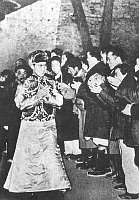| < Prev | Next > |
|---|
 On March 17, 1959 the 14. Dalai Lama, disguised as a simple soldier, escaped from Norbulingka, the Summer Palace in Lhasa.
On March 17, 1959 the 14. Dalai Lama, disguised as a simple soldier, escaped from Norbulingka, the Summer Palace in Lhasa.
This article reports about the dramatic escape and the role of the American CIA in the affair. You see old documentary film material and interviews with former CIA members and agents from the special Tibetan Task Force.
The Dramatic Flight of the Dalai Lama
Watch this video. It is exciting with interviews of former CIA agents and Tibetans who worked for the US Intelligence Service.
Shocking News from Lhasa, Tibet
In March of 1959 rumors were coming out from Tibet about a popular uprising in Lhasa, Tibet, and about the disappearance of the young Dalai Lama.
Imagine, in these days communication systems were not what they are today. And it was especially difficult to get reliable news from Tibet that had no telephone system in those days. There were no journalists sitting in Lhasa, and the only communication was by foreign diplomatic representatives via radio communication.
The Role of US Intelligence
The United States had no diplomatic representatives in Lhasa. But the CIA had two Tibetan agents sitting in Lhasa who had been trained in radio communication. This enabled the US to keep track of what was going on. The escape of the Dalai Lama was never initiated nor actively assisted by the CIA or any other US institutions. The decision to leave Tibet and the whole operation of the flight was a purely Tibetan affair. But the US played a role in assuring that India granted asylum to the Dalai Lama.
Escape at Night
The decision for the escape was made on short term but after thorough discussions. Even the State Oracle was advised. The group of refugees was comprised of 38 persons including the Dalai Lama, all his family members and several high ranking ministers and officials. In small numbers they had left the Potala Palace and the Norbulingka Palace to meet outside Lhasa. The Dalai Lama could sneak out from the Norbulingka Palace disguised as a simple soldier with a rifle in his hand and without his glasses in order not to be recognized.
The escape was secured by soldiers of the Tibetan resistance, mostly from the eastern Khampa tribe. Although the escape came on short term, it can be assumed that some preparations had been made before by the Tibetan resistance and the people around the Dalai Lama.
Chinese Man Hunt
The group left on March 17. The flight was covered by the Tibetans with a movie camera. For the Chinese the escape was a political disaster. After the disappearance of the Dalai Lama, the official Chinese version was that he was "kidnapped by bandits". The Chinese started a huge man hunt with road barriers, occupation of several border passes and by search planes.
It is quite astonishing that such a large caravan could make its way to India undetected. But one must remember the complete lack of modern communication and reconnaissance, the mountainous terrain and a complete lack of roads. Also bad weather with heavy snow storms were favorable to cover up the escape, but made the journey very stressful on the other hand. The Dalai Lama was said to have become rather ill with high fever.
Khenzimana Pass and Tawang Monastery
On March 30, the group could cross the Khenzimana Pass and make its way to Tawang Monastery, 50 kilometers within Indian territory, where they took a rest.
Asylum in India
When the Dalai Lama and his entourage fled Lhasa, they could not be sure if India would grant them asylum. India had been under considerable pressure from China for years and there were some ongoing border disputes between both countries. In this situation US diplomacy had used its influence that resulted in Nheru's decision to grant asylum to the Dalai Lama. This took place while the Dalai Lama was still on the flight and days before reaching India.
A few days after the successful flight, Jawaharlal Nehru arrived in person to welcome the Dalai Lama and assigned the Tibetans the hill location of Dharamsala in Himachal Pradesh, Northern India, as their new home in exile.
Escape Route
I could not find a document about the precise escape route anywhere. But when you look on the map with Lhasa in the North and Tawang Monastery in India, state of Arunachal Pradesh, in the South, the escape route looks rather straight forward.
{mosmap width='500'|height='400'|lat='27.57829'|lon='91.87636'|zoom='6'|zoomType='Large'|zoomNew='0'|mapType='Hybrid'|showMaptype='1'|overview='0'|text='Tawang Monastery in India'|lang=''}
More Information
For more information about the escape of the Dalai Lama and the role of the CIA in Tibet, see www.kefiworks.com.
Dieter Wanczura, July 2010.







